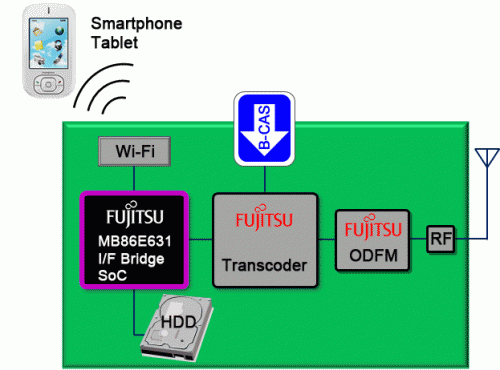Fujitsu Semiconductor releases Interface Bridge SoC incorporating 10 different interfaces

Fujitsu Semiconductor Limited today announced the development of Interface Bridge SoC "MB86E631," which brings together a dual-core ARM Cortex-A9 processor and a host of different interfaces, all on a single chip. Sample quantities of the new product will begin shipping in late December 2012.
MB86E631 incorporates a total of 10 different interfaces, including USB, Serial ATA, PCI Express, Ethernet MAC, and TS. As a result, the new product is an LSI featuring performance and functionality that has been optimized for CPUs for transcoder LSI control, as well as for products requiring control of a wide variety of interfaces.
The spread of smartphones and tablets has led to the availability of Wi-Fi TV tuner products that enable TV to be viewed on customer mobile devices. Such products are equipped with transcoder LSIs for performing video format and resolution conversion, as well as Wi-Fi modules and other technologies. A number of challenges are involved in selecting a CPU for controlling these technologies.
Multi-decoder LSIs used in video recording devices and communications processors for networking products are too powerful, whereas the performance of low-cost CPUs, such as microcontrollers, is insufficient.
At the same time, customers who manufacture video recording devices, TVs with built-in recording capabilities, and other products have expressed the need for a CPU with the ability to control a variety of interfaces capable of connecting to a wide range of different equipment.
Fujitsu Semiconductor developed Interface Bridge SoC "MB86E631" as an LSI that has been optimized to meet this need for both performance and functionality.
Featuring a dual-core ARM Cortex-A9 processor (~500MHz operations) as its CPU core, MB86E631 brings together a total of 10 different interfaces—including USB2.0/3.0, Serial ATA, PCI Express, Ethernet MAC and TS—all on a single chip. Not only is the product optimal for use together with a transcoder LSI in Wi-Fi TV tuner applications SoC, but it can also be employed as a CPU for interface control in multi-tuner devices and other applications in which control of multiple interfaces is required. In addition, the new chip will lead to the development of a new market that extends beyond video delivery and recording devices to include products that require performance greater than that of microcontrollers and support for multiple interfaces.
Product Overview
- Incorporates 10 different interfaces
- By incorporating interfaces such as USB2.0/3.0, Serial ATA, PCI Express, Ethernet MAC, TS, UART, and I2C, as well as the DDR3 and Quad Serial Flash Controller memory interfaces, the new series can be employed in a host of applications, including CPUs for transcoder LSI control and CPUs for interface control in multi-tuners that require the control of multiple interfaces.
- Features a dual-core ARM Cortex-A9 processor
- The new series employs an optimal CPU core for controlling its various embedded interfaces.
- Enables the delivery of Wi-Fi TV tuner solutions
- Fujitsu Semiconductor offers reference boards featuring MB86E631 together with the company's transcoder LSI. DLNA-compatible reference boards for Linux are also available as a solution for Wi-Fi TV tuner products, making product development easy.
More information: Key specifications of MB86E631: jp.fujitsu.com/group/fsl/downl … elease/20121016e.pdf
Provided by Fujitsu
















